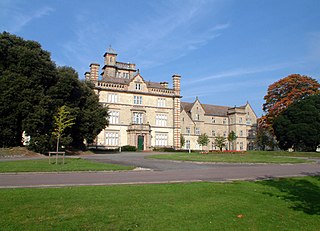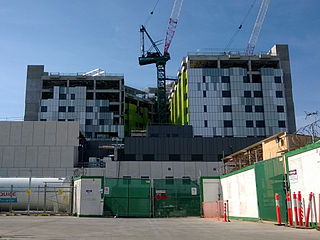
Monash Medical Centre (MMC) is a teaching hospital in Melbourne, Australia. It provides specialist tertiary-level healthcare to the Melbourne's south-east.

Glenside campus is the home of the Faculty of Health and Applied Sciences at the University of the West of England, in Bristol. It is located on Blackberry Hill in the suburb of Fishponds. Its clocktower is a prominent landmark, visible from the M32 motorway. Several of the buildings on the site are Grade II listed.
Glenside is a suburb in the local government area known as the City of Burnside, Adelaide, South Australia. The suburb is 4.9 kilometres south-east of the Adelaide city centre, home to 2,422 people in a total land area of 1.40 km2.

Flinders Medical Centre (FMC) is a major public tertiary hospital and teaching school, co-located with Flinders University and the 130 bed Flinders Private Hospital located at Bedford Park, South Australia. It opened in 1976. It serves as the trauma centre for the southern suburbs, and parts of the Adelaide Hills. An around-the-clock emergency retrieval service brings patients to FMC by road or helicopter.

Fulbourn Hospital is a mental health facility located between the Cambridgeshire village of Fulbourn and the Cambridge city boundary at Cherry Hinton, about 5 miles (8 km) south-east of the city centre. It is managed by the Cambridgeshire and Peterborough NHS Foundation Trust. The Ida Darwin Hospital site is situated behind Fulbourn Hospital. It is run and managed by the same trust, with both hospitals sharing the same facilities and staff pool.

Stobhill Hospital is located in Springburn in the north of Glasgow, Scotland. It serves the population of North Glasgow and part of East Dunbartonshire. It is managed by NHS Greater Glasgow and Clyde.

British Columbia Children's Hospital is a medical facility located in Vancouver, British Columbia, and is an agency of the Provincial Health Services Authority. It specializes in health care for patients from birth to 16 years of age. It is also a teaching and research facility for children's medicine. The hospital includes the Sunny Hill Health Centre, which provides specialized services to children and youth with developmental disabilities aged birth to 16 years.
TheQueen Elizabeth Hospital (TQEH) is an acute care teaching hospital in the western suburbs of Adelaide, South Australia. It provides a range of health services, including inpatient, outpatient, surgical, emergency and mental health services.

The Valkenberg Hospital is a large, government-funded, tertiary psychiatric hospital in the city of Cape Town, South Africa.

Riverview Hospital was a Canadian mental health facility located in Coquitlam, British Columbia. It operated under the governance of BC Mental Health & Addiction Services until it closed, in July 2012. In December 2015, the provincial government announced plans to replace the obsolete buildings with new mental health facilities, scheduled to open in about 2019. On October 12, 2021, the new Red Fish Healing Centre for Mental Health and Addiction opened on the site.

Beaufort War Hospital was a military hospital in Stapleton district, now Greater Fishponds, of Bristol during the First World War. Before the war, it was an asylum called the Bristol Lunatic Asylum, and after the war it became the psychiatric hospital called Glenside Hospital.

The Park Centre for Mental Health is a heritage-listed psychiatric hospital at 60 Grindle Road, Wacol, City of Brisbane, Queensland, Australia. It is one of the largest psychiatric hospitals in Australia. The hospital provides a range of mental health services, including extended inpatient care, mental health research, education and a high security psychiatric unit. It was designed by Kersey Cannan and built from 1866 to 1923. It is also known as Goodna Hospital for the Insane, Goodna Mental Hospital, Woogaroo Lunatic Asylum, and Wolston Park Hospital Complex. It was added to the Queensland Heritage Register on 21 October 1992.

St. Brendan's Hospital was a psychiatric facility located in the north Dublin suburb of Grangegorman. It formed part of the mental health services of Dublin North East with its catchment area being North West Dublin. It is now the site of a modern mental health facility known as the "Phoenix Care Centre". Since the official opening of the Richmond Lunatic Asylum in 1815 the Grangegorman site has continuously provided institutional facilities for the reception of the mentally ill until the present day. As such the Phoenix Care Centre represents the continuation of the oldest public psychiatric facility in Ireland.

Box Hill Hospital is a teaching hospital in Melbourne. It is one of the seven hospitals that are governed within the Eastern Health network which provides health care services across the Eastern metropolitan area of Victoria.

Blackberry Hill Hospital is an NHS psychiatric hospital in Fishponds, Bristol, England, specialising in forensic mental health services, operated by the Avon and Wiltshire Mental Health Partnership NHS Trust. The hospital also offers drug and alcohol rehabilitation inpatient services, and is the base for a number of community mental health teams.
Eastern State Hospital, located in Lexington, Kentucky, is the second oldest Psychiatric Hospital in the United States. It operates today as a psychiatric hospital with 239 beds providing inpatient care. Eastern State Hospital is owned by the Commonwealth of Kentucky, operated by the University of Kentucky's UK HealthCare and falls under the jurisdiction of the Cabinet for Health and Family Services.
Callington Road Hospital is a psychiatric hospital in Bristol, England. Opened in 2006, it primarily replaced Barrow Hospital, providing psychiatric inpatient and community services for Bristol and the surrounding region. It is run by the Avon and Wiltshire Mental Health Partnership NHS Trust.

Bexley Hospital was a psychiatric hospital at Old Bexley Lane, Dartford Heath, Bexley, in the County of Kent. It operated between 19 September 1898 and 2001.

Ailsa Hospital is a mental health facility located in the southeastern outskirts of Ayr, South Ayrshire, Scotland. It is managed by NHS Ayrshire and Arran.

Gransha Hospital was a health facility in Clooney Road, Derry, Northern Ireland. The site is managed by Western Health and Social Care Trust.

















